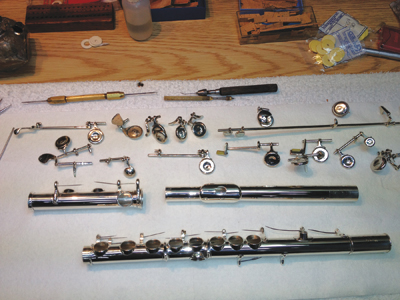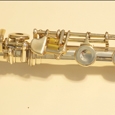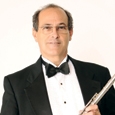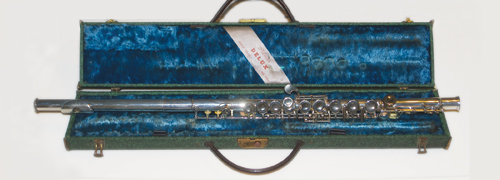
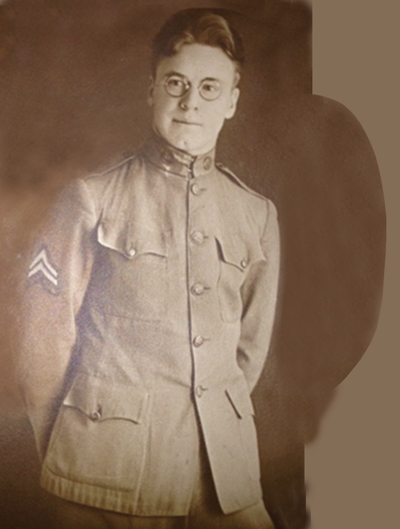 I first saw the Oril William Palmer flute in Music Delight, a local music store in Brooklyn, New York, and was taken by its eccentric design. The flute was in poor playing condition, but had a nice sound on the only three notes old, moldering flutes usually play: C#, C and B. After acquiring it, I began to investigate its origins. I sent photos to flute dealers and collectors all over the world, and no one had ever heard of this maker. The interior of the case had a blue, fine shag-like fuzzy material, with Palmer’s Delux Sioux Falls, South Dakota, written on a white satin sash across the inside of the lid. It was obviously made in the twentieth century, and the people at Conn placed it between 1930 to 1950, based upon the case interior. After more research I located Palmer’s grandson Kevin Palmer, a tenor saxophonist and woodwind repairman in Lincoln, Nebraska, and he agreed to restore the flute.
I first saw the Oril William Palmer flute in Music Delight, a local music store in Brooklyn, New York, and was taken by its eccentric design. The flute was in poor playing condition, but had a nice sound on the only three notes old, moldering flutes usually play: C#, C and B. After acquiring it, I began to investigate its origins. I sent photos to flute dealers and collectors all over the world, and no one had ever heard of this maker. The interior of the case had a blue, fine shag-like fuzzy material, with Palmer’s Delux Sioux Falls, South Dakota, written on a white satin sash across the inside of the lid. It was obviously made in the twentieth century, and the people at Conn placed it between 1930 to 1950, based upon the case interior. After more research I located Palmer’s grandson Kevin Palmer, a tenor saxophonist and woodwind repairman in Lincoln, Nebraska, and he agreed to restore the flute.
Kevin Palmer shared, “O.W. Palmer (1898-1974) was born in Minneapolis, Minnesota. While convalescing from rheumatic fever at age 10, a doctor prescribed playing a wind instrument to help with his recovery. An older sister got him a fife, and sometime later he was given a 5-key piccolo. Between the ages of 12 and 14, he learned to play the violin and performed in vaudeville pit orchestras on violin and piccolo. During WW I Palmer played piccolo with John Phillip Sousa, where he received the life-long nickname of “Pic” Palmer. By 1920, he left the army and played in pit orchestras for vaudeville and silent movies. Then he joined the Barnum and Bailey Circus playing piccolo where he met his future wife, horse stunt-rider Mina Jensen. Palmer learned C melody and tenor saxophone and joined the 5 Fat Dutchmen polka band. In 1926, out of necessity to repair his and his colleagues’ instruments, he started the Midland Sax Shop in Sioux Falls, South Dakota. Palmer formed his own band, Pic’s Pied Peppers, which gigged from 1936 to 1940, and whose band members included Lawrence Welk and Myron Floren. As with many bands in the late 1920s and 1930s, they played popular and dance music at some of the well-known speak-easies in the surrounding areas, such as the ABC Club, and the Wall Lake Pavilion. In the late 1930s and early 1940s Palmer was number one on the union players list and performed with Tommy Dorsey, Glenn Miller, and other bands at the Arkota Ballroom (still operational today) and the Melody Hall in downtown Sioux Falls. In the mid-1940s to the mid-1950s he played with the Lawrence Welk orchestra, but did not follow Welk to California for his television show. Palmer was the first flute with the Sioux Falls municipal band for 41 years.”
The motivation for Palmer’s flute making came from his dissatisfaction with the scale and intonation of the modern flute, particularly the third octave, and its harmonic overtones in general. To enhance the tone, scale, and projection, Palmer built his flutes with larger tone holes than conventional Boehm flutes of the time. He constructed his flutes with a longer headjoint and a shorter body compared to today’s flutes. The tube and tone holes were made in silver, with the tone holes uniform in size. The keys were made of an alloy, perhaps German silver or aluminum and copper.
The flutes, pitched at A=440, were handmade with soldered tone holes and German style keys (closed hole). The entire mechanism is pinless, and there is an adjustable split E. The C# tone hole is very tall, almost 1/3 of an inch and looks like a chimney. The ribs for the posts do not span the length of the body tube, but are quite short, curved to the contour of the flute tube, and soldered perpendicularly to the tube wherever a post is needed.
The thumb key has a large, three-quarter moon-shaped touch, and the thumb Bb touch is a smaller, full moon-shaped touch attached to a string that pulls down the Bb key on the main line. The string is similar to that which is used on the rotary valves of French horns. The G# key is very large and constructed with a double-lever mechanism so that it opens on the audience side of the flute, the same direction as the other keys open. The footjoint rollers are made of bakelite, and the D# key and rollers are angled for easier activation. It is worth noting that some of the radical design features found on the Palmer flute are being used on flutes produced today.
This flute has a traditional cut headjoint, with a medium amount of resistance. It has a surprisingly penetrating sound, with a feel and resonance very much like that of a wooden flute. It has a quick and accurate response for fast tonguing passages. The intonation is uncannily excellent in all three registers. The split E has a fuller, more natural sound on the high E than many flutes with the same feature.
Ergonomically, despite its larger size and unconventional key work, the flute is very comfortable in the hands. I love the shapes of the thumb and G# key. The mechanism has set screws for all leak adjustments, but because it is pinless, it does not adjust quite the same way as a conventional flute with set screws. If Palmer had made more flutes and had been able to create awareness of his instruments and market them, one can only speculate about his success. It is fascinating to see the work of a relatively unknown American flute maker, and to restore what was a viable alternative to the instruments of the time.
